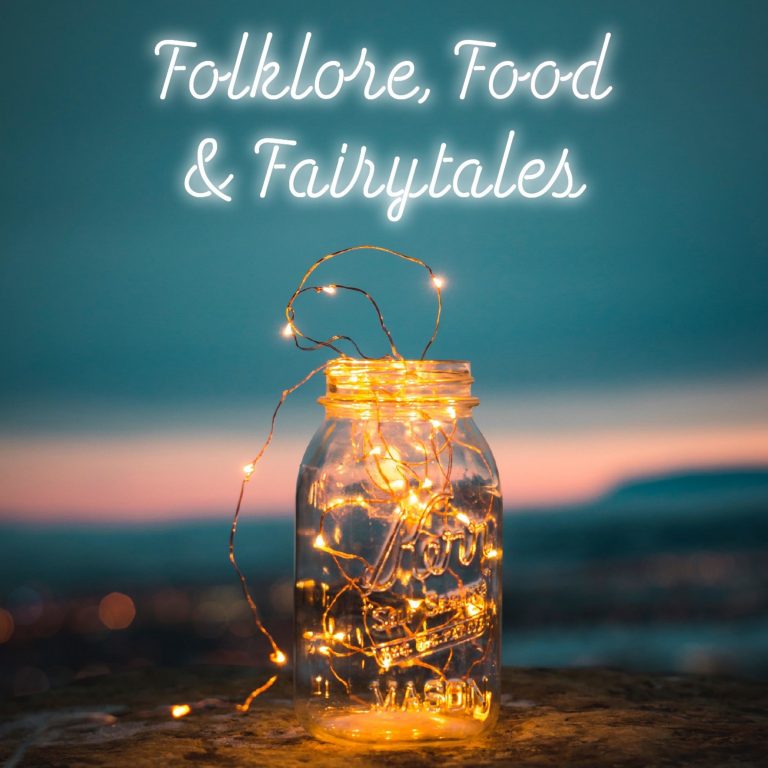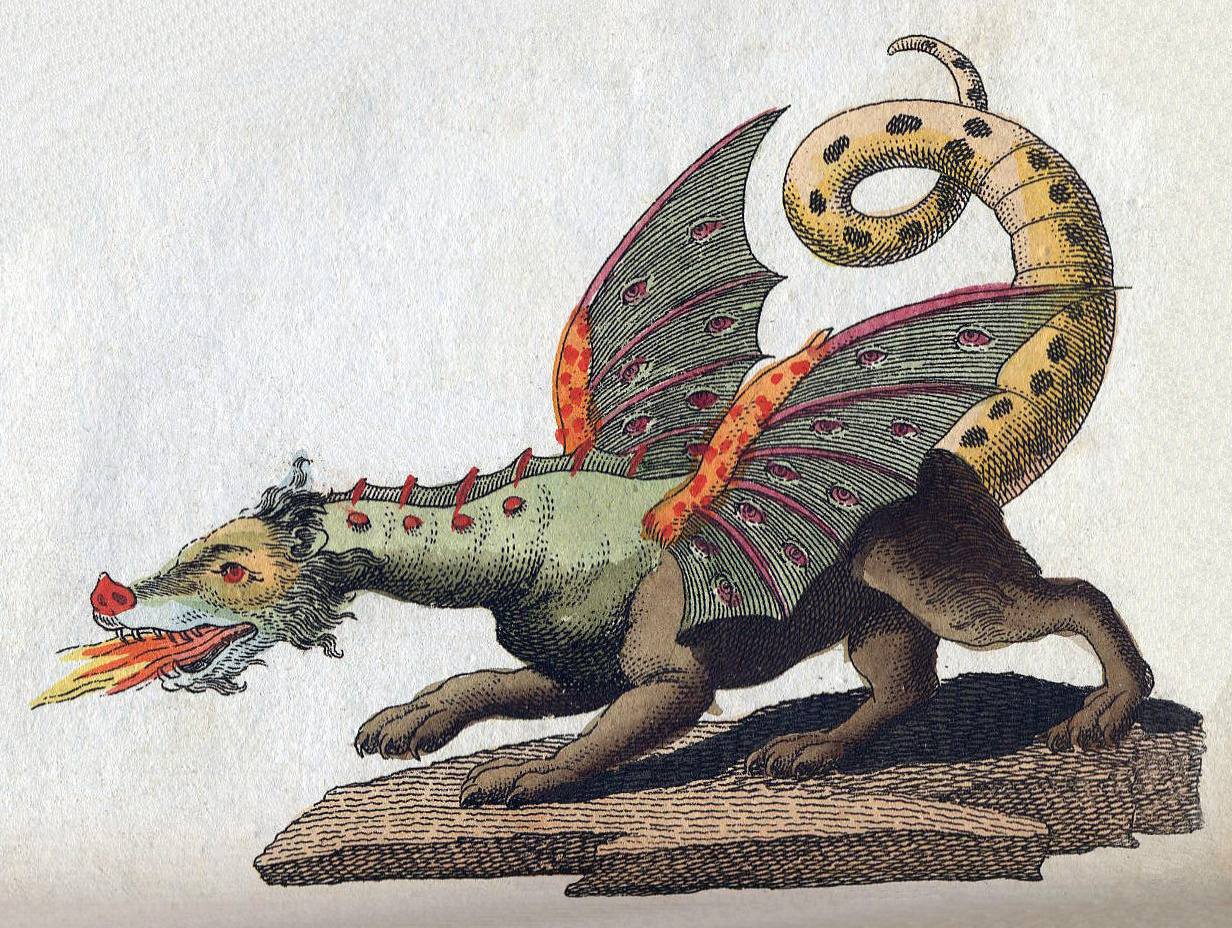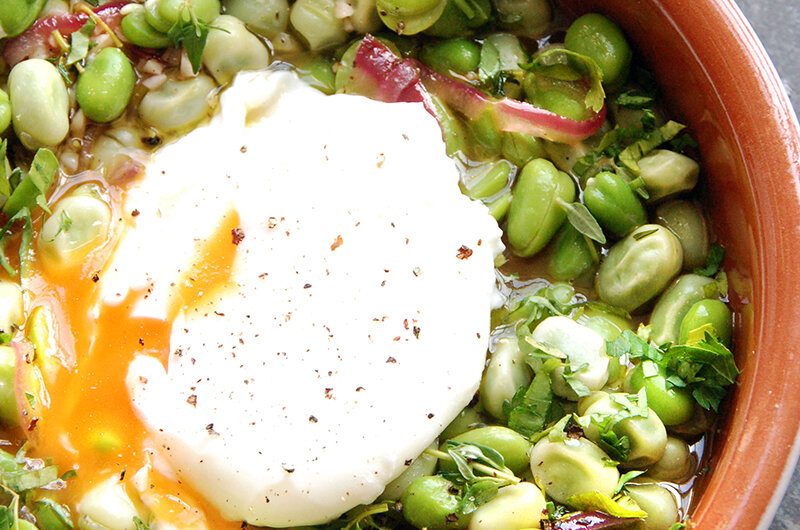In which we discover that a Tartalo can actually be grateful, that every time you save a princess you need a new horse, a new outfit and a new sword and that you should always dispose of any dragon’s heads responsibly. Additionally, we learn that you can know nothing about gardening and still grow beautiful vegetables and that it can take up to three days to kill a dragon.
In which we discover that a Tartalo can actually be grateful, that every time you save a princess you need a new horse, a new outfit and a new sword and that you should always dispose of any dragon’s heads responsibly. Additionally, we learn that you can know nothing about gardening and still grow beautiful vegetables and that it can take up to three days to kill a dragon.
The story for this episode is The Grateful Tartalo and the Erensugue as adapted from Basque Legends With an Essay on the Basque Language – Wentworth Webster, 1879
The recipe for this episode is Slow Simmered Broad Beans with Egg
If you would like to know a bit more about some of the links and books I used to research this episode you can find them at Further Reading.
You can also find out more at Hestia’s Kitchen which has all past episodes and the connected recipes on the blog. If you’d like to get in touch about the podcast you can find me on Twitter or Instagram at @FairyTalesFood.

The Dragon Slayer
What did you think of the story? It has some wonderful fantastic moments as well as some quite yucky ones. The story displays some of Basque folklore’s more well-known characters as well as having the elements of ATU tale type 300 – The Dragon Slayer. Shall we explore the tale-type before we move to the folklore elements? The beginning of this made me search through several books for the story it reminded me of. It was The Hairy Man, which I read first in Andrew Lang’s Crimson Fairy Book.
The Hairy Man
In that story the Hairy Man is captured by the king at some considerable trouble. He is then freed by the young prince. The prince escapes his father’s death sentence and wanders the forest until he is rescued by guess who? You’re right the Hairy Man. He lives with the man for several years until he leaves taking with him the gift of three amazing apples, one copper, one silver and one gold. The story progresses differently from then on but I’ll leave you to track it down for itself. Its a story believed to come from the Ukraine and Russia but there is also a German version – Iron John.
Italian, French or Celtic?
The rest of the tale though is pretty much pure dragon slayer if you exclude the purely Basque mythical elements. I would say that it is closest comparison to The Dragon with Seven Heads from Italo Calvino’s Italian Folktales. That hero also has the trio sword, horse and dog. He also keeps just the tongues and there is a false hero who pretends to be the princess’s saviour.
The false hero in that story is a coal man, bearing some similarity to the charcoal burner in our story. There are some big differences too as the hero is not a prince, doesn’t have magical help. He also has identical brothers which he murders because he thinks they have slept with his wife, the princess. This makes for a terrible ending until everyone remembers a magical salve. Its a fairy tale it doesn’t have to make sense.
There are many European variants of the Dragon Slayer and our tale also takes some things from Celtic tales. The three days’ fight, and the dog, appear in the Scottish “Tale of the Sea-Maiden”. It also has French elements like tour hero Petit Jorge or Small George and the Fleur de Lis. Apparently the original teller felt that had the almost miraculous to identify royalty in general and King’s sons in particular. You can understand the French influence as it lies so closes to Basque Country.
Paganism & Catholicism
We should now look at the particular Basque mythological elements in our story. The folklore of the Basque Country is very complex with a strong pagan base as you would expect of such an ancient civilisation tempered with devout catholicism . There are many excellent books on the topic but one element I found interesting was that pre-Christian Basque peoples appeared to believe that all things came from below the earth including weather. They also lived in great harmony with the earth and the most important figures in their mythology were goddesses rather than gods.
Exte
The other element that I found intriguing was the importance of the Basque concept of ‘Exte’ or ‘House’. I don’t think I can do it justice so here are the words of José Miguel de Barandiarán, a renowned Basque etymologist:
“It is of course a sacred place protected by the fire of the hearth—symbol of a spirit called Andra-Mari—that has supernatural virtues:
sacred because of the laurel growing in the garden or kept inside the house; because of various branches of hawthorn, ash, and flowers related to the solstice; because of the flower of the wild thistle, symbol of the sun; because of the axe and the hoe that are endowed with mystical powers; because it is the dwelling of spirits of ancestors or a place frequented by them; because of the perennial offering of light for the souls by keeping the hearth fire lit according to a ritual prescription or requirement of providing light for the dead even if it is only a single straw;
because of the practice of placing pious offerings of food intended for the dead members of the household on a shelf outside the windows; because of the ancient custom of constructing the houses so that the main entrance faces the rising sun; and, finally, because the house is the family cemetery.”
Tartalo and Erensugue
The two most important Basque mythological characters in our story were the Tartalo and the Erensugue. The Tartalo is a Cyclops who lives in the mountains and keeps sheep and is nearly always evil. He appears in some of the scariest Basque tales where it kidnaps some young person or captures someone forced by a storm to take refuge in his cave, then draws and quarters him, roasts him on the fire and eats him. You can see why his protective and helpful role in our story is very unusual. It feels in some ways as though he plays the part of a djinn in a bottle, always on call for the wishes. He’s more clever than he normally is in other traditional tales.
The Erensugue at least behaves more usually than the Tartalo in our tale. It appears in the form of a serpent, sometimes with seven heads, occasionally only with one. The end part of its name ‘sugue’ translates as serpent/snake. De Barandiarán considers it ‘one of the most important spirits’ in Basque mythology. The minor Basque mythological character is the Olano. This is an animal who serves the Tartalo, like a dog, but much larger and more terrible, but also more intelligent and able to carry out any message. I do only have Webster’s word for this last creature though.
The Basque Table
We’ll move to the food section of our discussion today. I have read several books on Basque food to further research this episode and you deserve to be made as hungry as I am. Basque food is simple but that doesn’t mean easy. They have spent a very long time making wonderful flavours from the best available ingredients. There is very little added to mask or confuse flavours so what you get is the true flavours of the foods, made to shine by experienced cooks.
San Sebastian has three Michelin starred restaurants and countless other wonderful restaurants especially those known for fantastic pintxos, the Basque equivalent of tapas. However at its heart is a cuisine of simplicity which rewards those cooks who can choose good raw ingredients and have an instinct in how best to use them.
Choice Ingredients
Even if this blog was novel length, I couldn’t do justice to the whole of Basque Cuisine. I’m just going to concentrate on some of the ingredients in the dish that the princess brings to the gardener. The toloso beans with pickled guindilla peppers, cabbage and blood sausage.
We’ll start with beans. Beans have traditionally played a large part in Basque cooking because the growing of them suits the climate. They also adapted very quickly to the beans that they brought back with them on their trading ventures to America. As Maria Jose Sevilla found when researching Life and Food in the Basque Country. This is a quote from a cook who lives the traditional farmhouse lifestyle:
“My brothers always demand beans as their first course and that gets tiresome’, explains Cándida. ‘We eat beans every blessed day of the year’. The beans are traditionally planted amongst the maize so that it provides a support for the climbing plants. In this way, the brothers kill two birds with one stone and do not need to erect bean poles for them. Every day, Cándida cooks the beans with a little carrot and onion.”
Beans, Beans, Good for the Heart
Alubias de Tolosa are famous because of the particular quality of the beans. Mark Kurlansky address this in The Basque History of the World:
“In the firmament of Guipúzcoan gastronomy there are many shining stars and alubias de Tolosa are generally considered one of premier magnitude.”
These red beans actually are black, but when they are cooked they turn red and produce a thick, chocolate-colored sauce. Tolosans believe the beans must be cooked in earthen crocks. Basques have done elaborate studies involving gelatinization of starches and the breaking down of cellulose to explain why beans should not be cooked in metal.They also believe that Tolosa is an ideal bean town because the surrounding area has noncalcareous soil, soil without calcium or lime, which produces the best beans. But at the same time, the calcareous water of Tolosa is thought to be the optimal liquid in which to cook the beans. Though currently the forty-seven officially recognized producers of Tolosan red beans sell them to be used elsewhere, it is believed that the true dish can only be made with Tolosan water. Busca Isusi suggested that cooks elsewhere try using rainwater.”
The producers sell the beans at the market in Tolosa. The market has been there since 1,256 CE (although these specific beans have only been around for a lot less than that). They even have an official competition every year to see who grows the best beans and who makes the best version of Alubias de Tolosa.
Green Guindillas
We’ll have a look now at the guindilla peppers. These are a specialty of the Basque Country. They can be grown elsewhere but they don’t taste the same. It is said that the red in the Basque flag comes from the peppers which were strung together to dry. They stood out dark red against the white houses, echoing the traditional red house trim. Here we are looking at the pickled green version and I’ll hand over to Maria Jose Sevilla and Candida again:
“The dish of chillies is empty and so Cándida tips in a few more from a jar. The family could not imagine eating red beans without some chillies to go with them. To prepare these she buys several kilos of the very small variety, then washes them and puts them in large glass jars with a chickpea and a clove of garlic. She fills each jar with half water and half wine vinegar; after a year in the larder, they will be delicious.”
The chickpea should keep the peppers bright green.
Sausages
Our last ingredient is the blood sausage. To protect any delicate constitutions I’ll just mention there is a traditional annual ceremony in the mountains. This results in these and many other traditional pork products. If you would like more details the epilogue of the Basque History of the World has a very detailed description.
A Lighter Bean
I hope I’ve given enough of a taste of this fascinating region and cuisine to make you find out more for yourselves. Today’s recipe is obviously bean based but I’ve gone for a lighter yet still fairly traditional recipe, more suited for this time of year and an excellent way to use either fresh broad beans or the really excellent tiny frozen ones. Its vegetarian but can have a meaty element added in the form of cured ham should you so wish.
It makes an excellent starter or one of a collection of pintxos, I love them with the egg but you might find that a bit big for a snack. You could maybe add lightly boiled quails eggs instead for prettiness and ease of eating. If you can get hold of Idiazabal cheese that would be wonderful but you could substitute Manchego or even pecorino if that’s easier to find.
Slow Broad Beans & Egg
4
servings30
minutes40
minutesIngredients
4 free range eggs
30ml olive oil
500g frozen baby broad beans
2 shallots chopped fine
100ml dry white wine
500ml veg stock
150g Idiazabal cheese
extra virgin olive oil for drizzling
black pepper
Directions
- Fry the shallots gently in the olive oil until they become a lovely light gold
- Add the broad beans to the pan, stir and cook for 5 minutes
- Add the wine to the pan and bubble off some of the booze (about 2 mins)
- Add 3/4 of the stock saving the rest to top up the pan if it gets dry
- Simmer the beans for 30 mins, keeping an eye on it to make sure it doesn’t catch
- When the beans are ready either poach or fry or boil your eggs to your liking (preferably with a runny yolk)
- Put beans in the bottom of a small bowl, add egg, drizzle with extra virgin olive oil, season and shave over some cheese
Notes
- Should you wish for extra meatiness, chop cured ham, fry and stir the oil and crispy ham into the beans.
Further Reading
Basque Legends With an Essay on the Basque Language – Wentworth Webster, 1879
Legends and Popular Tales of the Basque People – Mariana Monteiro, 1890
The Basque History of the World – Mark Kurlansky, 1999
Life and Food in the Basque Country – Maria Jose Sevilla, 1990
Jose Migel Barandiaran
Selected Writings of José Miguel de Barandiarán: Basque Prehistory and Ethnography – Compiled and with an Introduction by Jesús Altuna Translated by Frederick H. Fornoff, Linda White, and Carys Evans-Corrales, 2007
http://news.bbc.co.uk/1/hi/wales/1256894.stm
https://sites.google.com/a/amaroa.com/basque-mythology/antiguas-divinidades
http://www.buber.net/Basque/Folklore/aunamendi.mythology.php
https://en.wikipedia.org/wiki/Basque_mythology
https://en.wikipedia.org/wiki/List_of_Basque_mythological_figures
The Crimson Fairy Book, Andrew Lang
https://en.wikipedia.org/wiki/Princess_and_dragon
Featured Image – Illustration of a winged fire breathing dragon by Friedrich Justin Bertuch from 1806


